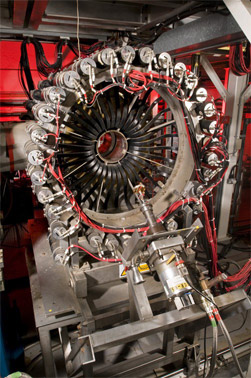A new class of unconventional superconductors
Tue, 03 Jul 2012 11:23:00 BST
Avant garde discovery for Huddersfield professor
The discovery of a new family of unconventional superconductors is a rare event. The University’s Professor Bob Cywinski (pictured below) is one of the scientists that helped make the latest discovery. The story below explains how this discovery came about.
_____

Researchers at the Rutherford Appleton Laboratory and at the universities of Kent, Bristol and Huddersfield, in England, have discovered a new class of very exotic unconventional superconductors.
Superconductivity is one of the most fascinating phenomena known to humankind. When a superconductor is cooled below its ‘critical temperature’, the fluid of electrons, which is responsible for the conduction of electricity through the material, undergoes a radical re-organisation. The electrons form ‘Cooper pairs’ and these Cooper pairs condense into a single, collective quantum state, which means they all behave as a single entity. This allows the manifestation of quantum-mechanical effects, which are normally confined to the world of sub-microscopic particles, on a scale that is visible to the naked eye.
Much recent research on superconductivity has focused on the internal structure of these Cooper pairs. While in conventional superconductors (and also in some high-temperature superconductors) the electrons in a Cooper pair have their intrinsic ‘spins’ pointing in opposite directions, so that the total spin of the Cooper pair is zero, in other, more exotic ‘triplet’ superconductors the electronic spins line up, so the Cooper pair has some intrinsic spin of its own. Such is the case, for example, of the strontium ruthernate Sr2RuO4, which is the paradigmatic example of a triplet superconductor. However, whereas in Strontium Ruthenate the Cooper pair spins are randomly-oriented, so that there is no net spin of the condensate of Cooper pairs in this material, in other, even more exotic ‘non-unitary’ triplet superconductors the spins of the Cooper pairs point in a particular direction. This comes about because the electrons whose spins point in that direction are more likely to form a pair than other electrons.

Left – The atomic-scale crystal structure of LaNiGa2, a material that presents a highly exotic type of superconductivity.
Until very recently, however, all known non-unitary triplet superconductors where so for a fairly simple reason, the materials were ferromagnetic, meaning that they were naturally magnetised and therefore even before the onset of superconductivity the spins of their electrons, which act as tiny bar magnets, were already aligned in a given direction. This changed in 2009 when three of the present authors reported measurements and theoretical analysis suggesting that the superconductor LaNiC2 was a non-unitary triplet superconductor [A. D. Hillier, J. Quintanilla and R. Cywinski, Phys. Rev. Lett. 102, 117007 (2009)]. This was surprising because LaNiC2 is not ferromagnetic, meaning that there had to be some as yet unknown mechanism whereby the electrons that paired up in Cooper pairs did so with their spins aligned in a particular direction. How did they chose this direction? Did the unusual crystal structure of this material, which unlike most crystal lattices is not symmetric under inversion, have something to do with it?
 Left – The MuSR spectrometer at the ISIS Facility, STFC Rutherford Appleton Laboratory.
Left – The MuSR spectrometer at the ISIS Facility, STFC Rutherford Appleton Laboratory.
Now the present team has produced evidence of another material having this exotic property, namely LaNiGa2 [A. D. Hillier, J. Quintanilla, B. Mazidian, J. F. Annett and R. Cywinski, Phys. Rev. Lett.]. Like in the previous case, the measurements were carried out using the muon spin rotation technique at the ISIS Facility, Rutherford Appleton Laboratory. In this technique, a powerful particle accelerator is used to bombard a sheet of graphite with a proton beam, producing muons, a subatomic particle that is then implanted in the material to be studied. After a few microseconds, the muon disintegrates, emitting a positron that is detected by the experimental apparatus. The direction of emission of the positron contains information about the atomic-scale distribution of magnetization inside the material.
Unlike its cousin LaNiC2, the crystal structure of the new superconductor does have symmetry under inversion, but the chemical similarity of the two compounds suggests that they are two instances of a new family of superconductors that have non-unitary triplet pairing even though they are not ferromagnetic. In this latest publication, the team puts forward a possible explanation, they show, by a very general reasoning based on the fundamental symmetries of nature, that the natural tendencies in these materials to magnetise under the influence of an externally-applied magnetic field, what is called ‘paramagnetism’, can lead to the development of a magnetisation in response to the magnetic moments of the Cooper pairs themselves. In other words, rather than relying on some pre-existing magnetisation, the magnetic moments of the Cooper pairs themselves create the magnetism that is required for their magnetisation to be energetically favourable – thus non-unitary triplet pairing can lift itself by its bootstraps. This would be a superconducting analogue of the way magnetism develops in ferromagnetic metals. A confirmation of this scenario would be quite spectacular, as it is a new form of magnetism that is generated by superconductivity.
The discovery of a new family of unconventional superconductors is a rare event. The challenge now is to reach a microscopic understanding of how this highly-exotic pairing structure comes about. There will also be a race to find more examples of this family as well as more experimental evidence, obtained with other techniques, of this unusual phenomenon.







